e-learning centre on sustainable development
CASE STUDIES IN SUSTAINABILITY
Living on an Island as the Sea Rises
Climate Change Disaster Risk Reduction in Vanuatu
Charles Pierce - 17 August 2017
http://bahaiteachings.org/learning-about-climate-change-disaster-risk-r…
and http://bahaiteachings.org/teaching-world-climate-change
Learning about Climate Change Disaster Risk Reduction
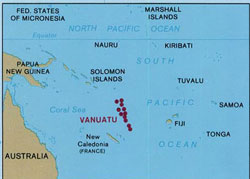
Note: Vanuatu was known as the New Hebrides until it gained independence from
Britain and France in 1980. It was mentioned in the Tablets of the Divine Plan, but it
was not opened to the Bahá'í Faith until October 1953.
Vanuatu, an archipelago of 80 volcanic islands in the South-West Pacific, is ground zero in the world’s fight against climate change.
As with other island nations, climate change is the most significant single threat to sustainable development, particularly because of the large proportion of the population living in coastal communities. Additionally, Vanuatu’s location on the Pacific Ring of Fire means that it is highly exposed to volcanic eruptions, earthquakes, tsunamis and landslides. According to the Commonwealth Vulnerability Index, Vanuatu is the most vulnerable developing country in the world.
So it is not surprising that Vanuatu was the first Pacific country to establish a Ministry of Climate Change. Nationwide efforts to include climate change and disaster risk reduction in primary and secondary education began some five years ago. In 2014, the non-government organization Vanuatu Rural Development Training Centres Association (VRDTCA) decided that a climate change course should be produced for use in some 35 rural training centers around the archipelago. Funding was made available from the German aid agency GIZ through its CCCPIR (Coping with Climate Change in the Pacific Island Region) program, and I was hired as a consultant to produce and deliver such a course.
As a Baha’i, I found this a perfect opportunity to be of service to the wider community and the planet’s fragile environment:
One of the most pressing problems of humanity in the current century is how a growing, rapidly developing, and not yet united global population can, in a just manner, live in harmony with the planet and its finite resources. Certain biological realities present themselves when an organism negatively affects or exceeds the capacity of its ecosystem. The limited availability and inequitable distribution of resources profoundly impact social relations within and between nations in many ways, even to the point of precipitating upheaval and war. And particular arrangements of human affairs can have devastating consequences for the environment. The question of the impact of climate change, and to what extent it is man-made and its effects can be ameliorated, is today a major aspect of this larger problem. The Revelation of Baha’u’llah directly and indirectly touches on a range of such concerns in a manner that speaks to a harmony between society and the natural world. It is essential, therefore, that Baha’is contribute to thought and action regarding such matters. – The Universal House of Justice, 29 November 2017, to a group of individual Baha’is.
Taking inspiration from the Baha’i teachings, the admonition of Baha’u’llah to carry forward an ever-advancing civilization, and the Baha’i sequence of Ruhi courses, I designed the climate change course materials in a way that emphasized participatory learning and promoted reflection and learning through experience. Interactions between students, and between students and communities, were to be conducted with humility, with a focus on consultation between the parties concerned. Emphasis on fostering unity and coherence was paramount, since these attributes are key factors in strengthening community resilience to hazards and climate change.
It took almost three years for this project to reach fruition. I had to produce the materials in English and then translate them into French. Two pilot courses had to be run in the outer islands to test the effectiveness of the learner guides, learner workbooks and facilitator guides. In the end, I created 56 booklets, 28 in English and 28 in French. VRDTCA was dissolved in 2015 and its functions assumed by the Ministry of Education’s TVET department. The Vanuatu Qualifications Authority had its own requirements that had to be fulfilled: this involved considerable modification to the original content, and a tortuous process towards achieving official accreditation of the course. A fresh organization had to be found to host the delivery of the program—eventually identified as the Vanuatu Institute of Technology (VIT), located in the capital city of Port Vila on Efate Island. More funding had to be negotiated through the EU-PacTVET project supported by the Pacific Community (formerly the South Pacific Commission).
But in mid-February of 2017, this first-ever certificate course in climate change and disaster risk reduction (CCDRR) finally began. I moved to Port Vila to spend the next six months there, with a couple of short breaks that enabled me to return to Western Australia. At the official opening, the Director-General of Education said how proud the government was that the Vanuatu Institute of Technology was delivering the first-ever certificate course in CCDRR, and additionally, the first-ever such course in the Pacific region.
The first cohort of 31 students came from all six provinces of Vanuatu. Twenty-seven used materials in English, and four used French, but the language of delivery was the native language of Vanuatu, Bislama. Although the course had originally been designed for students in rural areas whose education had only reached Grade 10 level, those selected from over one hundred applicants included only two at this level; the rest had finished high school education or had completed up to two years of college degree courses. This huge variation in academic level posed one challenge. Another was the age range and maturity of the participants, which varied from 18 to 40. There were 21 males and 10 females. Many students had families, and in some cases they had to deliver their children to school before they themselves could come to class. Those who came in from the islands were able to board at VIT, but the majority of the cohort were day students.
Topics covered by the course included hazard risks in Vanuatu, climate and climatic variations, causes and effects of climate change, mitigation of and adaptation to climate change, vulnerability and impacts, the importance of traditional knowledge in building community resilience, and the promotion of community action to prepare for climate change and disaster risk reduction. The basic aim was to empower the learners to become agents of change in their communities, able to conduct awareness programs and demonstrate practical techniques of mitigation and adaptation.
An integral part of the course was fieldwork—surveys in the immediate vicinity of the Institute of Technology, visits to peri-urban villages around Port Vila, longer trips further afield to communities in north-west Efate and the island of Pele, and a residential field course on the island of Emao. Students learned how to present key concepts to each other, to other students at VIT and to village communities. They did research to produce hazard risk maps, discover traditional techniques of weather prediction, food preservation and fishing, and analyze the adaptive and coping capacities of communities; established their own agro-forestry plot in the grounds of VIT and practiced how to do coral planting to replace degraded reefs; conducted scientific experiments on the heating of water and the melting of sea- and land-based ice; shared learnings on traditional knowledge with a partner from another island; prepared and shared action plans for building resilience to disasters in five communities; and took a two-day course in First Aid so as to be able to handle emergencies during hazard events.
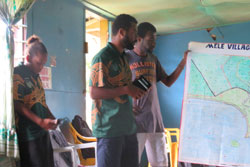
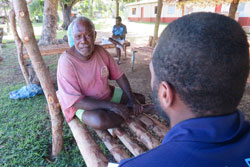
CCDRR team explaining the risk map of Mele village to the village council; investigating traditional knowledge on disaster risk reduction
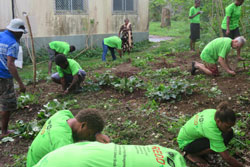
Weeding the CCDRR agroforestry plot
Together, the students and I went on a remarkable journey to discover ways to live on an island as the sea rises around us and stronger storms batter us—to deal with an unprecedented global environmental crisis.
Teaching the World about Climate Change
The basic teachings of Baha’u’llah call upon all humanity to foster a united world:
Our greatest efforts must be directed towards detachment from the things of the world; we must strive to become more spiritual, more luminous, to follow the counsel of the Divine Teaching, to serve the cause of unity and true equality, to be merciful, to reflect the love of the Highest on all men, so that the light of the Spirit shall be apparent in all our deeds, to the end that all humanity shall be united, the stormy sea thereof calmed, and all rough waves disappear from off the surface of life’s ocean henceforth unruffled and peaceful. – Abdu’l-Baha, Paris Talks, p. 87.
Baha’is believe in the oneness of God, religion and humanity; freedom from prejudice; harmony of science and religion; independent investigation of truth; equal opportunities for women and men; and universal education:
Baha’u’llah has announced that inasmuch as ignorance and lack of education are barriers of separation among mankind, all must receive training and instruction. Through this provision the lack of mutual understanding will be remedied and the unity of mankind furthered and advanced. Universal education is a universal law. – Abdu’l-Baha, The Promulgation of Universal Peace, p. 300.
As I taught the island nation of Vanuatu’s first climate change and disaster risk reduction course (CCDRR), those central principles were implicit in the course, and sometimes, very explicit.
After one session in which we looked at the length of time the Earth has been in existence and the environmental havoc wreaked by humanity in its brief period on the planet, students were visibly affected. They asked me: “So why are you teaching this course? What is your motivation?”
That question led to a separate session (after class) on the Baha’i Faith. I was also able to involve several students in the activities of the local Baha’i community.
Assessment of progress in each of the seven sections of the course was made under five criteria—oral communication, field research, reflection on learning, completion of workbook activities, and a short summative test. Feedback was provided on a continuous, often daily, basis. The focus was on empowering the students to take charge of their own learning, and gain the capacity to share their knowledge and skills with others. As such, it was essentially a practical, hands-on course designed to equip the students to help their own communities.
Throughout the program, I was assisted by Ms. Jill Hinge, a local trainer at the Vanuatu Institute of Technology. When it is next offered at VIT during 2018, it is likely that Jill will be in charge!
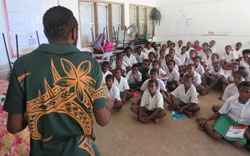
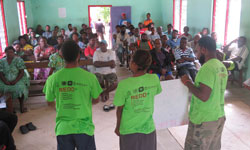
Awareness talks on climate change at Mangarongo Centre School, Emao, and to people in Marou Village, Emau, conducted in the church
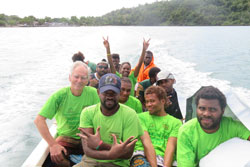
Returning from field work on Emao
Three students were unable to complete the course, but 28 successfully and joyfully graduated in August of 2017 in the presence of Vanuatu’s Minister of Climate Change, the Director of Education Services and other dignitaries. It was a proud moment. After the course finished, I went with one of my students to the remote island of Mota in the Banks, and saw firsthand how he could interact with the people in his community and share many of the concepts that he had learned during the course. This was the icing on the cake!
One CCDRR student said “This course has equipped me to be an agent of change in my community. It helps me to understand about climate change and other topics so that I can explain them. It also gives me courage to talk in a large crowd of people, so it helps me to make my community more resilient.”
Another student said “My community lacks knowledge about the impacts of climate change and doesn’t know how to overcome the effects of natural hazards and climate. So what I have learned will help the community to adapt and do mitigation measures.”
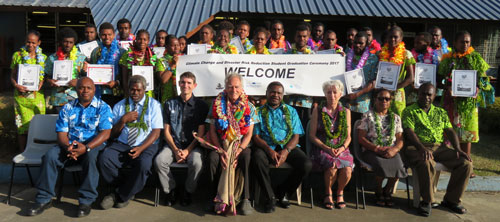
Graduating students with the Minister of Climate Change, personnel from VIT
and the Department of Education and Training, and representatives of donor agencies
After graduation, those who had been seconded from the Departments of Forestry and Agriculture and the National Disaster Management Office returned to their former employment. Some have resumed their studies. Most, however, are either waiting for suitable employment opportunities with national or provincial governments or NGOs, or else have decided to simply return to their islands to share their knowledge and skills in their own communities. All are anxiously anticipating the creation and delivery of a higher level certificate course in resilience (climate change and disaster risk reduction) on which I am now working.
The writing and delivery of this course had many challenges, but in watching the gradual empowerment and growing confidence of the learners, I would say that this whole experience has been the most exciting and fulfilling chapter in my entire teaching career.
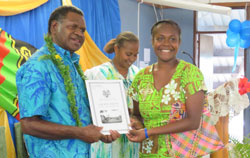
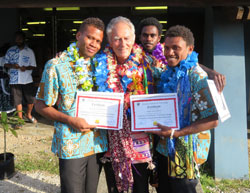
Claudette Toa receives her certificate from the Minister for Climate Change with Assistant Facilitator Jill Hinge looking on; students from the Banks Islands (Enory Wogale and Reggie Moffitt) and Tanna (Nickson Iata) with course facilitator Charlie Pierce
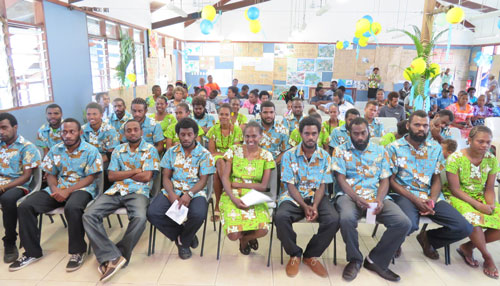
Graduating students
Charlie (Charles) Pierce is a long-serving teacher and curriculum writer who grew up in England but spent most of his life in Vanuatu, having gone there as a Baha'i pioneer in 1971. He is currently living with his wife Barbara in Albany, Western Australia. His areas of expertise are geography, geology and climate change. In June 2017, he was awarded the MBE by Queen Elizabeth for services to education in Vanuatu.

